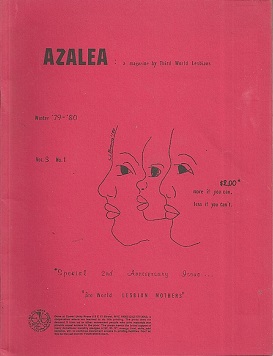Azalea: A Magazine by Third World Lesbians facts for kids

Vol. 3, Issue 1 cover
|
|
| Frequency | Quarterly |
|---|---|
| First issue | 1977 |
| Final issue | 1983 |
| Company | Salsa Soul Sisters, Third World Wimmin Inc Collective |
| Language | English |
Azalea: A Magazine by Third World Lesbians was a special magazine published from 1977 to 1983. It came out four times a year. The magazine was made for Black, Asian, Latina, and Native American women. It was created by a group called the Salsa Soul Sisters, Third World Wimmin Inc Collective. This group also published another newsletter called Salsa Soul Sisters/Third World Women's Gay-zette.
The Start of Azalea Magazine
The magazine Azalea was named after a strong flower that blooms in spring. It was started in 1974 by Joan Gibbs, Robin Christian, and Linda Brown. They were part of a group called the Black Lesbian Caucus in New York City. This group was connected to the Gay Activists Alliance (GAA).
At that time, there were no magazines that published stories by women of color. These women felt that mainstream publications often ignored their voices. So, instead of waiting for others to include them, they decided to create their own platform.
Joan Gibbs, one of the founders, explained why they started Azalea: "People were always complaining that white feminist and lesbian magazines weren’t publishing writings by Black and Latina women. So, I decided, why don’t we just start our own magazine and stop complaining? There’s no point in complaining constantly. You just do it yourself."
The main goal of Azalea was to publish stories from women of color without changing them. The magazine wanted to create a space where these women could share their true thoughts and experiences.
A quote from the magazine's introduction explained this idea: "Azalea was created partly because we feel that many feminist and/or lesbian publications build walls around themselves. It has been our experience that when standards are set in this country, the people who set them are often white. They have not tried to include people from diverse backgrounds."
The magazine made it clear that it wanted to offer a place for writers from different backgrounds. Azalea was an important part of helping minority voices be heard. It continued this mission until 1983, when its last issue was published.
What Was Inside Azalea?
Rodger Streitmatter, who wrote a book about gay and lesbian publications, noted something special about Azalea. The founders wanted to avoid repeating unfair practices. They decided not to "assess the quality of contributions sent to them." This meant they would publish all material without editing it.
This policy was clearly stated in every issue of the magazine: "We print what you send us; anything that is important to us, Third World women. We welcome work from 'newcomers' as well as 'regulars.' One of our goals is to publish writers and artists from diverse backgrounds whose work has never appeared in Azalea. So, sometimes we might need to ask women whose work has been in two issues in a row to wait for a later issue or submit something else at another time."
Azalea's main goal was to fill a gap in magazines that often left out Black and Latina writers.
The magazine published stories and art from Africa, Asia, and South America, as well as from the United States. The first issue that listed authors featured famous writers like Toni Morrison, Audre Lorde, Toni Cade Bambera, Pat Parker, Lorraine Hansberry, and Zora Neale Hurston. Azalea published three issues each year from 1977 to 1982. In its final year, 1983, it published two issues.
Writers Who Contributed
Here are some of the people who wrote for Azalea:
- Donna Allegra
- Becky Birtha
- Linda Jean Brown
- Robin Christian
- Michelle Cliff
- a. S. Natwa
- Joan Gibbs
- Julie Blackwomon Carter
- Robinet LaVerne Christian
- Michiyo Fukaya (Michiyo Cornell)
- Audre Lorde
- Anita Cornwell
- Rosita Libre de Marulanda
- Sapphire

